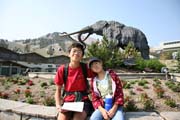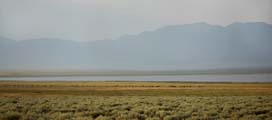The Eastern Sierra is vast, rugged, and sparsely populated. This
landscape is the meeting place of the Sierra Nevada, the Great Basin, and the
Mojave Desert. Not only is the Eastern Sierra diverse, it also claims a
number of unparallel features: Mount Whitney, the tallest peak in the
contiguous US; Inyo Volcanic Chain, one of the youngest volcanic region in the
country; Palisade Glacier, the southernmost active glacier in the US; Mono
Lake, one of the oldest bodies of water in existence on our continent; and
western bristlecone pines, the world's oldest living organisms.
Getting there ...
In this trip, we only covered the northern half of the Eastern Sierra: from
Mono Lake to the White Mountains. Unfortunately, Iris got a cold before
the trip and was not well enough to participate in many hikes. She got a new
accessory, the water bottle, to ease her cold, so she got her new nickname
"water bottle girl" for this trip (check out her pictures to find the water
bottle).
- Tioga Road, Yosemite
We stopped by the White Wolf campground to get some lunch and let Linus and
Iris recover from the long drive. Since Tioga Road has a higher elevation,
we were glad to see the temperature cool down as we went on.
- Tenaya Lake
We took a short hike to the western shore of the Tenaya Lake. The
beach here is quite special because the shallow water can extend into the
lake for tens of feet with the depth only up to our knees. We spent
more than an hour here wading through the cool water, and enjoyed the nice lake
view.
- Tuolumne Meadows
I was planning to take some hiking here, but Iris was too weak to go on any
further than a few steps from the car....
- Sunset at Mono Lake
I went to the South Tufa area alone for the sunset. The light was good,
the weather was calm, the sky was clear, but there were so many bugs (alkali
fly) that you can see a thin layer of "cloud" over the lake shore.
The Second Day ...
- Bodie Ghost Town
The town of Bodie rose to prominence with the decline of mining along
the western slope of the Sierra Nevada. The huge gold strike started a
wild rush to the surrounding high desert country. By 1879 Bodie
boasted a population of about 10,000 and was second to none for wickedness,
badmen, and "the worst climate out of doors". The most profitable
mining era at Bodie was short lived , lasting only about a decade (between
1877 and 1888, it yielded $35 million in gold and silver). By the late
1880s, most of the mines were closed and the population dwindled to a few
hundred people. After the fire in 1892 and 1932, Bodie was virtually
abandoned, and it became a State Historic Park in 1964.
- Lundy Canyon
After coming back to have a lunch break in Lee Vining, we headed to the
Lundy Canyon. It was very hazy today that the smog from various wild
fires in California may had been blown to this way. After passing the Lundy
Lake Resort, a narrow dirt road continues for about another mile farther
west up Lundy Canyon. A tranquil and secluded area with a moderate 1.5-mile
hike goes into the wilderness along Mill Creek, heading past beaver dams and
plenty of wildflowers. Iris was reluctant to walk on her own, so
Woanyu and I had to take turns to carry her especially when we hiked uphills.
The Third Day ...
- Sunrise
I went back to the South Tufa area for sunrise. With the right
amount of cloud and haze, it was one of the most ideal golden hour naturally
displayed.
.
- Devils Postpile
Basalt
lava erupted in 100,000 years ago. As the lava cooled it contracted and
cracked, forming the symmetrical vertical and hexagonal columns of
Devils Postpile. Some 20,000 to 12,000 years ago a glacier flowed down
the San Joaquin River and overrode the fractured mass of lava, and
carved away one side of the postpile, exposing a sheer wall of columns
60 feet high.
During the summer season, visitors have to stop at Mammoth Mountains and
take the shuttle bus into the park. Iris was still not well enough
to take a long hike. We only took the short walk from the ranger
station to Devils Postpile, and only Linus and I took the trail to the
top of postpile which reveals a cross section of glacially polished
columns that look like floor tiles. |
 |
- Bishop
After lunch at Mammoth Mountains, we headed south to Bishop to visit the
Mountain Light Gallery by late
Galen Rowell. There are many Galen's classical images on the display,
which have inspired me when I just picked a camera a long time ago. We
also tried to find a beef jerky store called
Mahogany recommended by my friend
Dave, but we missed it when we first came, and when we found it on our way
back, it was already closed.
- Ancient Bristlecone Pine Forest, Schulman Grove
In the White Mountains, the ancient bristlecone pines show a preference
for growing on the white, rocky soil, Dolomite, which is very alkaline and
thus makes for very challenging growing conditions: precisely why the oldest
trees are found here. There are many bristlecone pines here in the
White Mountains that exceed 4000 years of age, and are still growing.
We took the short 1-mile Discovery Trail loop, but Iris and Woanyu decided
to turned back just after a few steps because Iris refused to walk by
herself. Linus and I kept going with a faster pace because the weather
started to change: from clear blue sky to windy overcast in just minutes.
It started to rain big rain drops, and we had to begin to run downhill
because it was so exposed and we heard thunder come near and near.
 |
On our way back down the White Mountains, my Prius hybrid car started to
over charge the battery because it's so steep downhills. Suddenly,
it began to show a
few big warning signs on the dash board, and Woanyu and Linus were busy
looking up for instructions in the Prius User's Manual!
We had a dinner in Bishop so we did not have to rush back to Lee Vining.
After the break, we were all back to the normal condition (including my
Prius). |
The Last Day,
- Mono Lake
Finally we found time to visit South Tufa area together since we stayed
in Lee Vining.
Mono Lake is at least 700,000 years old, one of the oldest continuously
existing lakes in North America. Mono Lake is naturally salty and
alkaline because it has no outlet. Tufa towers are the most intriguing
features in Mono Lake. Made of calcium carbonate, tufa is formed
beneath the lake's surface when fresh water containing calcium enters the
lake from underground springs and combines with the carbonate-rich lake
waters. Most shoreline tufa were not visible until the 1940s, when
Mono Lake began to drop as a result of water diversions by LA City.
- Tenaya Lake, Yosemite
We headed back to Yosemite to have a brunch at Tuolumne Meadow, and
then went to the last stop of this trip: the eastern end of Tenaya Lake.
Unlike its western end, there is a sandy beach on this side of lake shore,
and it's considerably more crowded here too.
Going Home ...
Though less famous than neighboring Yosemite and Death Valley, the Eastern
Sierra always has a reputation as one of California's premier settings for
outdoor recreation and nature study. We have only covered a small portion
of this amazing vast land, and we did not even complete most of our hiking plans
because Iris was not in a good condition. We will come back to this wild
land to explore more of its backcountry and experience its different seasons.
[Back to Photo Page]
[Eastern Sierra Gallery]